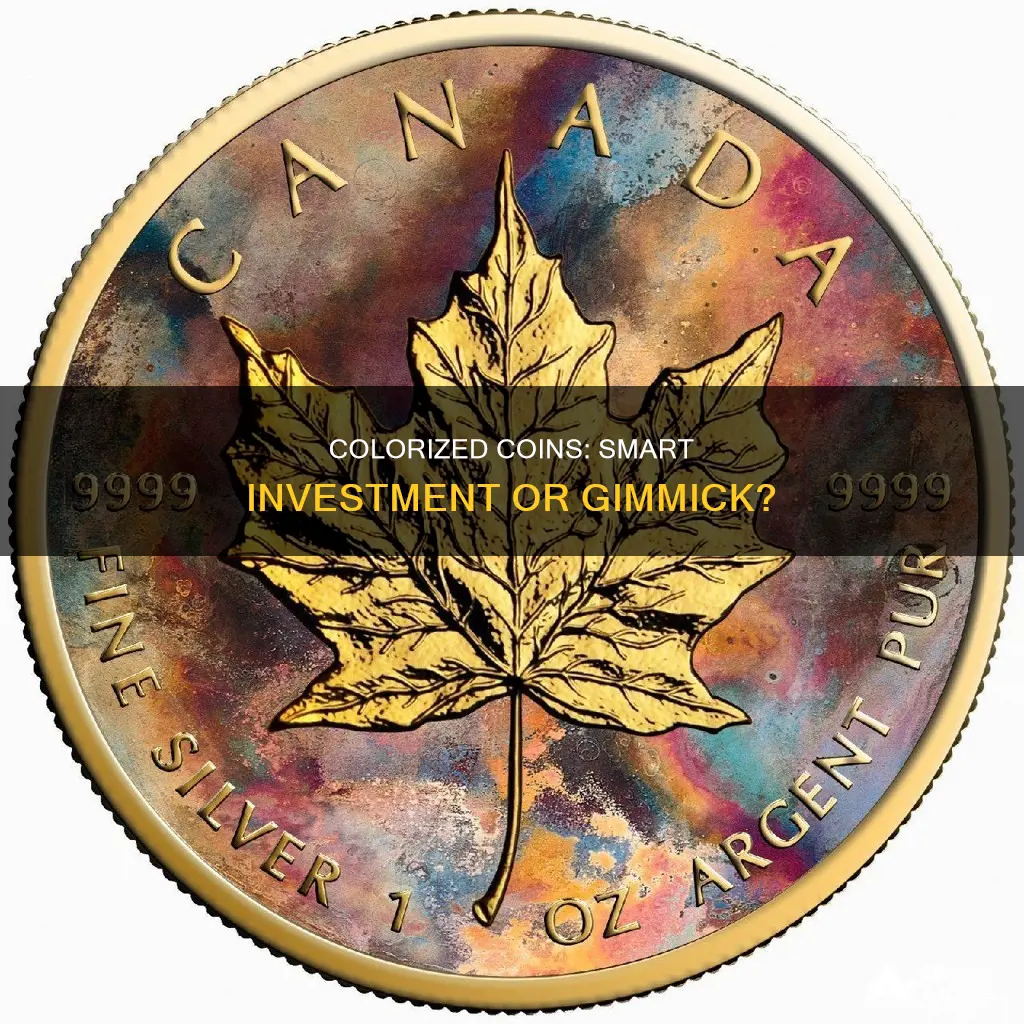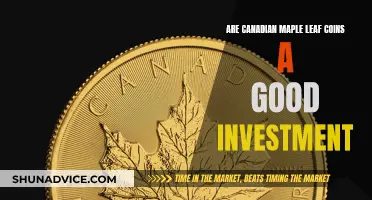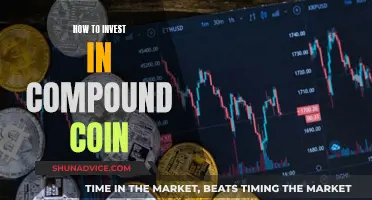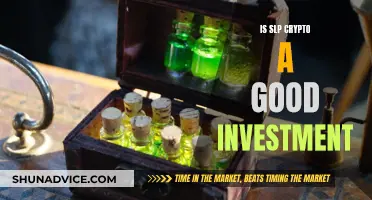
Colorized coins are a unique type of currency that has been treated with a special coating or paint to give them a distinct colour or design. While they may be aesthetically pleasing and a fun addition to a coin collection, they are generally not considered a good investment. The resale value of colorized coins is typically lower than the original purchase price, and most coin collectors prefer their coins in Mint State, without any added colours or alterations. Additionally, the process of removing the colouring can damage the coin, further reducing its value. However, there are a few exceptions, such as limited-edition bullion coins produced by certain mints, which may gain value over time due to their rarity and licensed designs.
What You'll Learn

Colorized coins are not a good investment
There is a very small and selective market for colorized coins. Most colorized coins with state flags, painted backgrounds, glow-in-the-dark paint, or holographic material have almost no resale value compared to the price they were bought at. For example, a set of four holographic quarters may cost $20 to buy new, but will be hard to sell for even $5. Most collectors wouldn't even trade a regular quarter for a colorized one.
Coin collectors generally dislike colorized coins for three main reasons:
- They prefer their coins in Mint State, which means the coins have not been altered in any way since leaving the mint.
- Removing the coloring from a coin will damage it.
- Colorized coins are incredibly overpriced for what they are.
Colorized coins are also difficult to authenticate and grade due to the added color or layers, making it challenging to determine their true value. They may not be widely accepted in the coin-collecting community, and some collectors view them as a way to artificially inflate a coin's value.
If you are looking for a coin that is a good investment, you want one that will grow in value over time. Any colorized coin that is reproducible is unlikely to gain value. However, some limited-edition bullion coins made by certain mints may gain value over time. For example, The Simpsons Collection of Silver Rounds produced by the Perth Mint has increased in value due to its limited quantity and licensed characters.
Bitcoin vs. Stocks: Where Should You Invest?
You may want to see also

They are considered more as a collectible item
Colorized coins are considered more as a collectible item than an investment. They are usually created by adding colours to the coin after the minting process. This can be done by painting the coin or electronically plating different metals to it.
The market for colorized coins is very small and selective. Most colorized coins have little to no resale value, and their value is likely to appreciate less over time. For example, a set of four holographic quarters that costs $20 to buy new may be hard to sell for even $5.
Collectors generally dislike colorized coins for three main reasons:
- Most collectors want their coins in Mint State, and removing the colouring damages the coin.
- They are incredibly overpriced.
- Any reproducible coin is unlikely to gain value.
However, some colorized coins may gain value if they are limited edition and produced by certain mints. For example, The Simpson's Collection of Silver Rounds produced by the Perth Mint has increased in value due to its limited quantity of 5,000 and its licensed characters.
Colorized coins can be a fun and rewarding hobby for those interested in numismatics. They can add a unique and visually striking element to a coin collection. However, their impact on the coin-collecting industry is somewhat controversial, as some collectors view them as a legitimate form of coin alteration, while others see them as a way to artificially inflate a coin's value.
When evaluating the value of a colorized coin, several factors should be considered, including rarity, age, quality of colourization or layering, condition, and demand among collectors. It is advisable to consult experts or coin appraisers before making any investment decisions.
Buffett's Take on Bitcoin: The Oracle's Investment Strategy
You may want to see also

They are not rare
Colorized coins are not a good investment because they are not rare. There is a very small and selective market for them. Most colorized coins with state flags, painted backgrounds, glow-in-the-dark paint, or holographic material have almost no resale value compared to the price they were bought at. A set of four holographic quarters may cost you $20 to buy new, but will be hard to sell for even $5. Most collectors wouldn’t even trade a regular quarter for a colorized one.
The process of adding color to coins is not new. The history of colorized or layered coins spans more than 30 years. In its infancy, colorized coins were hand-painted with enamel paint. Later, people began applying stickers or appliques to cover one side of the coin with a colorful image of the coin itself or something completely different. While these stickers were not as attractive as a hand-painted product, they satisfied the demands of a mass audience.
Today, there are close to 50 sovereign nations that offer colorized coinage, and there are many hundreds of different issues. The topics range from world leaders to cartoon characters, from race cars to every conceivable type of animal or insect. The more often a cultural icon is represented on a colorized coin, the more the general public seems to like it. Witness the number of colorized coin offerings for superheroes, video games, exotic animals, and newly released movies, and how quickly they sell out as soon as they are offered.
The market for buying and enjoying colorized coins shows no signs of abating. If even the staid and conservative U.S. Mint can issue a couple of colorized coins, then which world mint would not follow along? However, their value is likely to appreciate less over time.
Selling Stockpile Bitcoin Investment Trust Shares: Anytime?
You may want to see also

They are overpriced
Colorized coins are overpriced for several reasons. Firstly, they are considered more of a collectible item than an investment, and their value is not likely to increase significantly over time. In fact, their resale value is often much lower than the original purchase price. For example, a set of four holographic quarters may cost $20 to buy new, but will be challenging to sell for even $5.
Secondly, colorized coins have a very small and selective market. Most collectors are not interested in them and would not trade a regular coin for a colorized one. This limited demand means that prices are unlikely to rise, and reselling may be difficult.
Thirdly, the process of colorization often involves adding a thin layer of metal or paint to the coin, which is then sold at a premium. However, the added material is usually of negligible value, and the coin's original value remains unchanged. This means that buyers are often paying a higher price for a coin that has not actually increased in worth.
Finally, the artificial alteration of a coin through colorization is often seen as detrimental to its value by experienced collectors. The act of removing the coloring to restore the coin to its original state can also damage the coin, further reducing its worth.
For these reasons, colorized coins are generally considered overpriced and not a good investment.
Schwab Bitcoin Investment: Is It Possible?
You may want to see also

They are difficult to authenticate
Colorized coins are not a good investment. They are generally not valued by collectors and are difficult to authenticate.
Colorized coins are coins that have been treated with a special coating or paint to give them a unique colour or design. They are often considered a collectible item rather than an investment. While they may hold some value as a collectible, their value is unlikely to increase over time. In fact, their value is often significantly less than the price they were bought at.
The difficulty in authenticating colourised coins stems from the added colour or layers, which can make it challenging to accurately assess the coin's condition, grade, and overall value. The additional colour or layers can obscure the underlying details of the coin, making it difficult to verify its authenticity.
Furthermore, colourised coins are often created by painting or altering the coin after it has left the mint, which can be seen as artificial inflation of the coin's value. As a result, they may not be widely accepted in the coin-collecting community, and some collectors may view them as altered or damaged coins.
Additionally, colourised coins are typically mass-produced and reproducible, further reducing their potential for value appreciation. The market for colourised coins is very small and selective, and most colourised coins have little to no resale value compared to their original purchase price.
In summary, colourised coins are difficult to authenticate due to the added colour or layers, which can obscure the underlying details and make it challenging to accurately assess their condition, grade, and value. They are often not accepted by collectors, who may view them as artificially inflated or altered coins. As such, they are generally not a good investment option for those seeking financial growth over time.
Tracking Bitcoin Investments: Is It Possible?
You may want to see also







